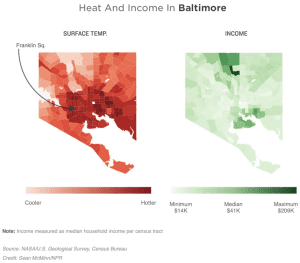The urban heat island effect is making cities significantly warmer than surrounding rural areas – a growing challenge in a warming world. Urban heat islands are metropolitan areas that experience significantly higher temperatures than their surrounding rural regions. When paired with hotter summers and rapidly growing urban populations, it creates a dangerous combination with serious implications for public health, urban wildlife, and the environment.

Urban heat islands are one of many consequences of the Anthropocene, a period marked by rising greenhouse gas emissions, global warming, more frequent and severe weather events, and rising sea levels. And with over half of the global population already residing in urban areas, and more people moving into cities every year, this is not a problem that will go away without intervention.
The Urban Heat Island Effect and What Causes it
The urban heat island effect refers to the phenomenon where daytime and nighttime temperatures in cities are higher than in their surrounding rural landscapes, particularly during summer months.
There are several causes of the urban heat island effect in cities, many of which are directly linked to human activities.
Heat-Absorbing Surfaces in Cities
Buildings, sidewalks, and streets absorb heat energy from the sun and slowly release it throughout the day and into the night. This is why nighttime temperatures in cities often remain elevated.
Lack of Urban Trees
Trees, vegetation, and even soil help lower surface and air temperature by providing shade or cooling through evapotranspiration. However, many cities lack sufficient tree cover – especially in densely built or low-income areas – making them more vulnerable to extreme heat.
Urban Canyon Effect
Tall buildings in cities create “urban canyons” that block wind flow, which would otherwise help cool city air. These structures can also trap hot air, preventing it from dispersing and causing temperatures to rise further.
Waste Heat in Cities
Heat released from vehicles, air conditioning units, and industrial processes adds to the overall warmth of urban areas. This human generated heat further intensifies the urban heat island effect.
Urban Heat and Human Health
Heat islands negatively affect all people in a city, but not all in the same way or to the same extent. The urban heat island effect disproportionately affects lower-income communities, where civil services such as tree planting, park maintenance, cooling centers, and public health outreach often fall short. These neighborhoods typically have fewer green spaces and less heat-resistant infrastructure, such as shaded bus stops, than higher-income neighborhoods, making residents more vulnerable to extreme heat.

High temperatures increase the risk of heat-related illnesses such as heat exhaustion, heatstroke, and even death – especially among the elderly, young children and those with preexisting health conditions. The American Heart Association offers helpful summertime habits to stay safe during extreme heat events.
Heat Islands’ Impacts on Wildlife
Urban heat islands don’t just affect people—they also harm city wildlife. Many urban areas lack adequate trees and greenspaces, which reduces access to food and shade, increasing the risk of overheating, dehydration, and habitat loss for animals that rely on these environments to survive.
Environmental Impacts of Heat Islands
The urban heat island effect can worsen air quality. Hotter temperatures cause pollutants and greenhouse gases from vehicles and industrial sources to become trapped closer to the ground, contributing to smog formation and respiratory health issues.
Measuring Urban Heat Islands
Scientists measure urban heat islands in several ways, including satellite imagery, ground-based sensors, weather stations and thermal mapping with data visualization tools. These methods help monitor temperature differences between urban and rural areas, allowing researchers to assess heat intensity and inform urban planning strategies to reduce its impacts.
What Can We Do About Urban Heat Islands?
The EPA provides a comprehensive list of heat island reduction solutions that can be adopted by individuals and cities. Below are a few solutions that can be easily implemented.
- Plant Trees, Flowers, and other Vegetation: Planting trees, flowers and other vegetation is an effective way to help combat high temperatures caused by urban heat islands while also creating shaded areas for both people and wildlife. If you’re considering it, the EPA offers some helpful guidelines for adding green space to your community.
- Learn to Adapt to Heat: The EPA suggests that everyone – especially people living in urban environments – better prepare themselves for higher temperatures and heat waves. Here are ways you can plan for, monitor, educate, and bring awareness to the impacts of increased temperatures caused by the urban heat island effect.
- Reduce Energy Consumption: Reducing energy consumption from non-essential household appliances during peak times can help lower overall electricity demand and reduce excess heat generation inside homes.

Urbanization and Heat Islands
The urban heat island effect is a clear example of how human activity can intensify environmental and public health challenges – especially in rapidly growing cities. Heat islands and climate change go hand-in-hand, so as we face rising temperatures and more frequent heatwaves, it’s essential to understand the causes and consequences of this phenomenon. Fortunately, there are steps individuals and communities can take to reduce its impact. Through urban heat island mitigation techniques, from planting trees and vegetation to learning how to better adapt to heat and reducing energy consumption during peak hours, we can begin to cool our cities and protect the communities most at risk.
Image credits: Urban heat island profile (TheNewPhobia, Public domain, via Wikimedia Commons); Heat and income in Baltimore (Sean Mcminn, CC BY-SA 3.0, via Wikimedia Commons); Children planting a tree (Community Tree Day (Fall 2021) by City of Greenville, North Carolina is Public domain)


